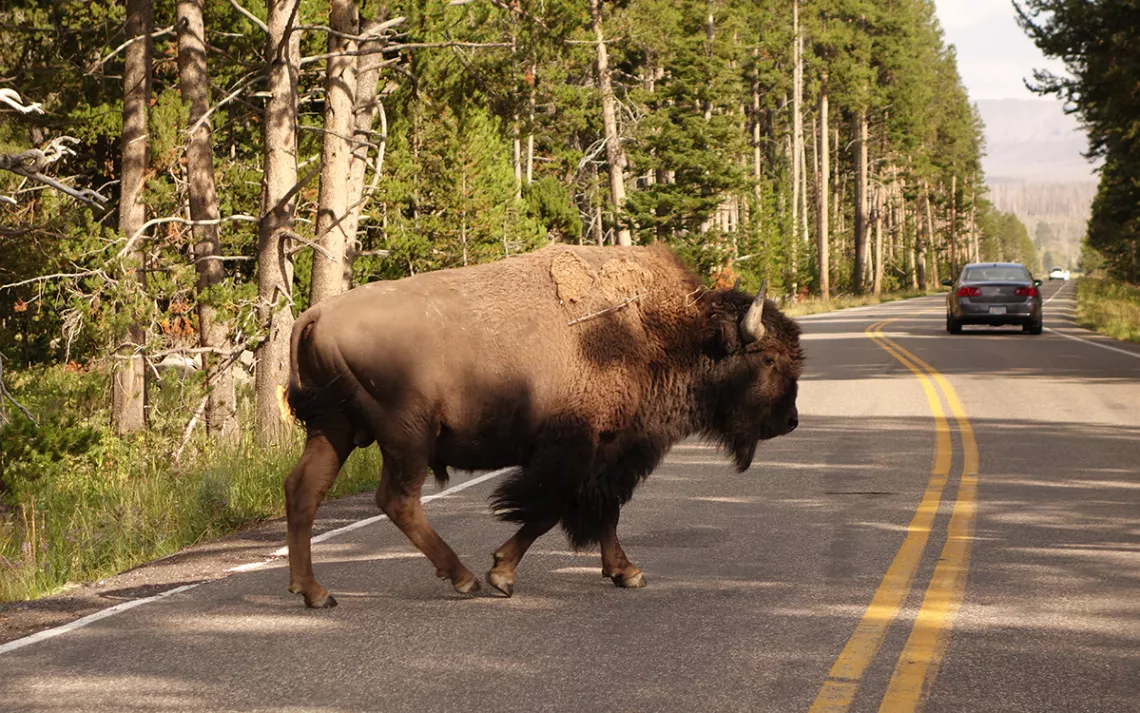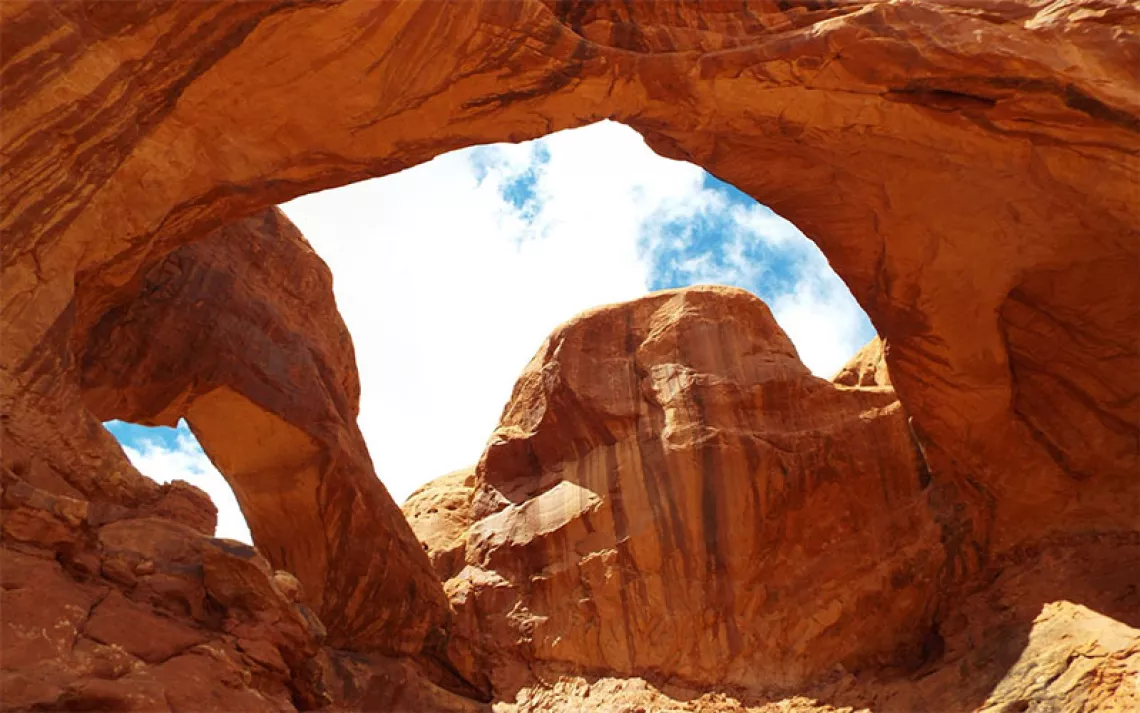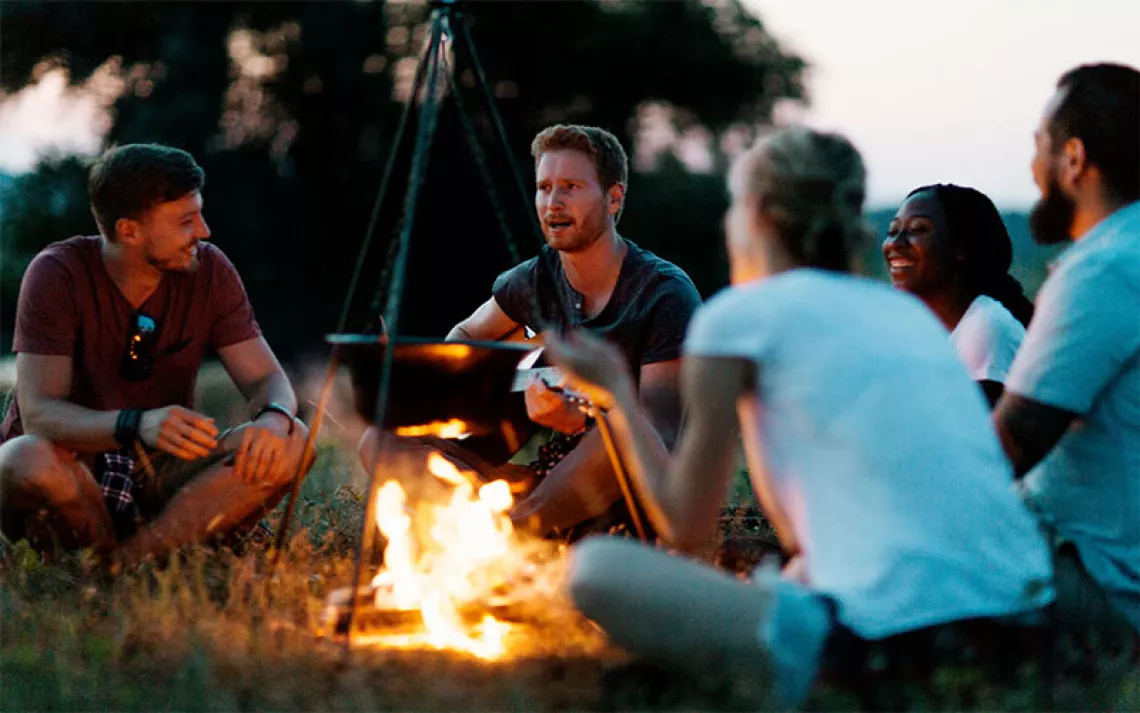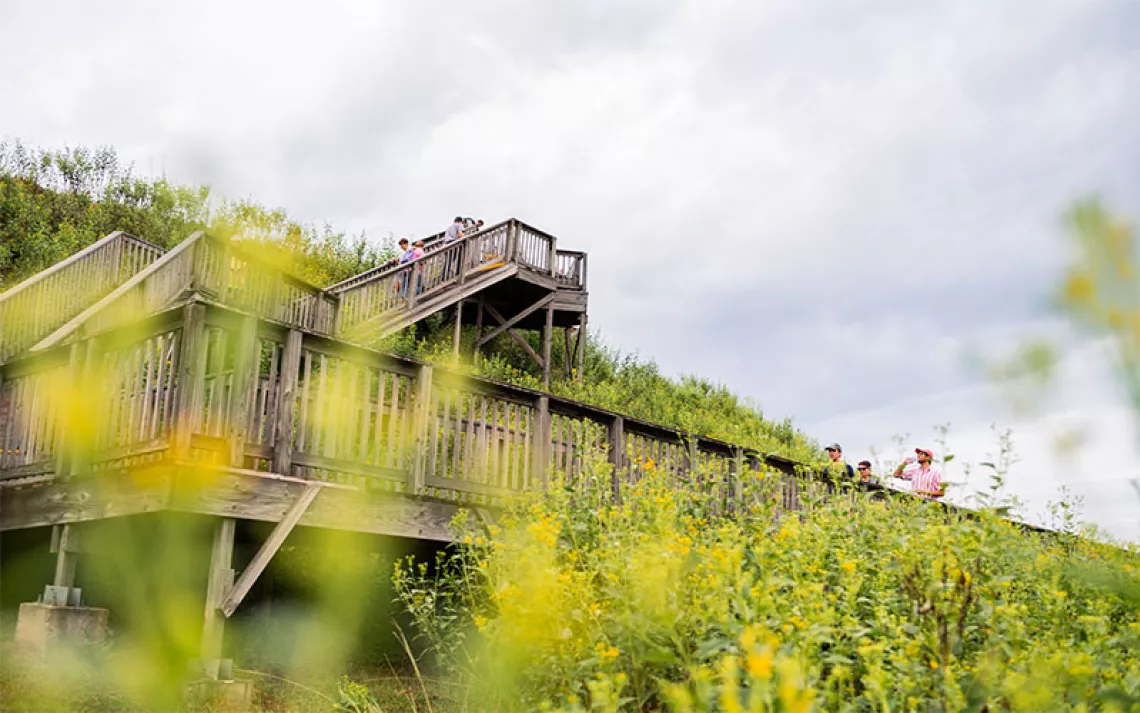Can Indigenous Leadership Save Our National Parks and Monuments?
The nomination of Chuck Sams signals a new path for Indigenous-led and managed Native homelands

Photo by Jacqueline Keeler
My ancestor Sunka Isnala, Lone Dog, is said to have been born in Yellowstone in 1802, in the vicinity of what became designated, 70 years later, Montana’s Yellowstone National Park. His father, Tawapah’a, Red Warbonnet, was Sisseton Dakota but joined his wife's Sicangu Lakota band, the Tis’aoti, Red Lodges, because their tipis were painted red at the top. According to my great-aunt Susan Bordeaux Bettelyoun, “They dwelt between the Black Hills and the country lying around Laramie where the buffalo ranged.” I am descended from his daughter Huntkalutawin, Red Cormorant Woman. Her brother, Swift Bear, became chief.
Most of Huntkalutawin’s Lakota descendants, the Bordeaux family, now hail from the Rosebud Sioux Reservation in central South Dakota. My father's Dakota family descended from her son John Bordeaux and live on the Yankton Sioux Reservation in southeastern South Dakota. Her descendants live in tribal communities far from Wyoming and the spectacle of one of Yellowstone’s most famous attractions, Old Faithful, where throngs of tourists from all over the world gather to watch it go off like clockwork. We rarely think of ourselves as having a connection with that place.
When I was there a few years ago, my family and I drove those roads, stopping to see Old Faithful and the Artist Paint Pots. At one point we were stopped by a herd of buffalo crossing the road. As our little Native family stared at the buffalo and they stared back, calmly standing their ground—some on the asphalt, others in the timber on both sides of us—I was struck by how amazing it is that they, and we, were still here at all.
The Americans had targeted the Tatanka (bison) for genocide as an act of total war against Native people. In 1868, General Sheridan wrote to General Sherman that they must “make them poor by the destruction of their stock, and then settle them on the lands allotted to them.” In a few years, millions of bison were slaughtered for fun and profit by white “hunters,” their flesh left to rot in huge mounds. Their population plummeted from an estimated 30 million to a few hundred by the end of the 19th century.
The cattle and Europeans that arrived to replace us had each been bred and shaped for millennia by ancient systems of domestication and peonage. The term “pioneer” is derived from the French term for the disposable “peons” sent ahead of the regular army. That feudalism, dressed up in the language of freedom and progress and driven by the economic needs of colonialism and profit, could not abide genuinely independent beings like us. And by “us,” I mean my Dakota/Lakota ancestor and the Tatanka. Our relationship with each other and the land was not built on peonage and domestication but mutual respect. Even now, that organizing principle threatens the new order of extraction and exploitation.
These old relationships we once held with the Tatanka oyate (and still do in our hearts) could help fight climate change. A large-scale prairie restoration project in Oklahoma uses a buffalo herd to help reestablish the ancient prairie grasslands, which contain more biodiversity than many rainforests. Perennial, these grasses can live up to 50 years of age and plumb the soil 15 feet deep, and they can also store carbon. The buffalo were brought in to graze a former cattle stockyard and have brought back the prairie through their natural grazing patterns.
But pioneering lingers on in new ways. White ranchers are wary of the buffalo herd in Yellowstone and routinely call for its reduction through hunts and culling. They claim the buffalo carry a disease, brucellosis, that could harm their cattle. As a consequence, several thousand bison have been slaughtered since the 1980s from a herd that is comparatively small to their historical population. Wildlife advocates say the brucellosis argument has been thoroughly discredited. The National Park Service reports that the bison herd is increasing in size at a high rate of 10 to 17 percent per year—a rate that belies claims that brucellosis infection is causing fetal death. Under Montana state law, buffalo are designated as game, not wildlife, and the Yellowstone herd must be kept to 3,000, although advocates claim that the park can maintain a herd four times that size.
Typically, the NPS invites tribes to participate in the hunt but does not consult them on whether this is the best management practice. Calls to add the Yellowstone bison to the endangered species list due to their unique genetic purity have so far gone unheeded. Last year, media reported hunters shot buffalo in plain sight, with shocked tourists looking on.
*
I greeted the news of Umatilla tribal leader Chuck Sams's nomination to lead the National Park Service with both surprise and a certain amount of optimism. If confirmed, he will be the first citizen of a federally recognized tribe to lead the NPS since the agency was created in 1916.
Sams is Cayuse and Walla Walla, two tribes that are part of the Confederated Tribes of the Umatilla Indian Reservation in southeast Washington and northeast Oregon. He is also of Yankton Dakota descent on his father's side. His boss will be Interior Secretary Deb Haaland, the former representative from New Mexico and a Laguna Pueblo citizen. Haaland was not only one of the first Native women to be elected to Congress in 2018 along with Ho-chunk citizen Representative Sharice Davids (D-Kansas) but also the first Native American to lead the Department of Interior, where she holds decision-making powers over vast areas of the United States and its waterways. The possibility of two Native people having such extensive oversight of our homelands is without precedent in American history. What could it mean for places like Yellowstone, for the bison that roam there? Or for lands like Bears Ears, repeatedly targeted for exploitation?
Sams will be taking the reins at a time when the National Park Service is struggling to adapt to a confluence of challenges, including chronic underfunding, the COVID-19 pandemic, climate change, and a national fight over public lands and the federal government's ownership of them. The Far Right demands that these lands be handed over to the state and even to counties for management and ownership. There have also been long-standing issues of equitable access to the parks, and NPS staff have been overwhelmingly white; despite efforts to change that, there has been little movement.
By 2018, lack of funding for the National Park Service had ballooned to $12 billion in deferred maintenance. Some wildlife advocacy organizations including the Center for American Progress and the Center for Western Priorities have questioned the $12 billion figure, noting that about half was for road building and maintenance that should be funded through transportation bills, not the Park Service. They allege that the Trump administration was using the figure to promote the idea that parks and monuments are too expensive to be run by the public and should be privatized, a notion put forward by the conservative think tank Property and Environment Research Center (PERC).
Ironically, a solution to the funding crisis came in the form of a bipartisan bill, the Great American Outdoors Act of 2020, signed into law by former President Trump (not known as a champion of the NPS after he reduced national monuments like Bears Ears and Grand Staircase–Escalante). The law guarantees $900 million per year of royalties from offshore oil and natural gas drilling for the Land and Water Conservation Fund. The LWCF finances federal land acquisition and outdoor recreation grants for states. The act also created a new program, the National Parks and Public Land Legacy Restoration Fund, to pay for deferred maintenance on public lands.
During the pandemic, Americans sought to get away from the confines of quarantine to enjoy the great outdoors. Trails became littered with trash and human feces as maintenance of restrooms proved difficult with reduced staff. This, in turn, endangered water and habitat and provided a pathway of contagion for both human visitors and wildlife. Meanwhile, the national parks have faced climate-change-induced forest fires on a scale not seen before. Western drought is now being recognized as a more permanent form of aridification. Add to this a summer of wildfires raging across the West, hurricanes and flooding battering coastal regions, the loss of habitat, destruction of infrastructure, fallout in rivers, streams, and lakes, the growth of toxic algae, and toxic air making trail maintenance more difficult. What pathways could a Native director of the National Park Service possibly take out of this mess?
According to writer and historian Wallace Stegner, national parks were "the best idea we ever had. Absolutely American." He also called the establishment of the parks "absolutely democratic," never mind tribes that lived there had no say. "They reflect us at our best rather than our worst," Stegner declared, in spite of the fact that the establishment of national parks was only made possible by the violent removal of Indigenous nations from the land in question. The "us" Stegner is referencing is the white America that invaded Native lands.
With this history in mind, in a recent piece in The Atlantic, Ojibwe writer and historian David Treuer called Yellowstone "a crime scene." In an interview on PBS Newshour, he called for the park's return to the Shoshone Bannock and other tribes. And not just Yellowstone. Treuer is calling for the return of more than 60 national parks, from the Grand Canyon to Joshua Tree—over 80 million acres all told. Despite claiming on PBS Newshour not to have plans, just ideas, he lays out a compelling argument for national parks to be turned over to a consortium of tribes.
Treuer recounts in his article how just five years after Yellowstone, the first national park was established by President Ulysses S. Grant in 1872. It was where Chief Joseph's people, the Nez Perce (Nimipuu), were infamously hunted down by the US army even as white American tourists enjoyed the views. This summer, Glenn Nelson, a writer and wildlife photographer, documented his recent trip following the Nez Perce Trail. The trail is a series of national monuments and parks that commemorate the path Chief Joseph's people took as they attempted to seek safety in Canada from American aggression. "The monument at Battle of Canyon Creek Historical Site, part of Nez Perce National Historical Park," he notes, "has seen better days. Here, Chief Looking Glass's snipers held off the 7th cavalry so the Nez Perce Tribe non-combatants could put some distance on the US Army."
"It may be that Americans will have to come face to face with the loathsome idea that their invasion of the New World was never a movement of moral courage at all," wrote Dakota writer and professor Elizabeth Cook-Lynn in her essay "Why I Can't Read Wallace Stegner." "Rather, it was a pseudoreligious and corrupt socioeconomic movement for the possession of resources. It may be that the Plains Indians are not 'done,' as assumed in Stegner's fiction; rather, they continue to multiply and prosper."
Can Native leadership save our Indigenous homelands? Or is this, once again, the case of the “glass cliff?” A term describing how in a moment of crisis, a woman or person of color is brought in to lead and take the blame if they fail?
*
There are examples.
The Navajo Nation (of which I am a citizen), runs six tribal parks, including the world-famous Monument Valley Tribal Park and Lake Powell Navajo Tribal Park, without direct federal subsidy. In 2018, pre-pandemic, the largest Navajo national park, Monument Valley, attracted about 400,000 visitors per year and brought in over $4 million in revenue from entrance fees, tours, and filming permits.
In 2018, the Navajo Nation finally signed a co-management agreement with the National Park Service for Canyon de Chelly, the only national monument on tribal land (established 86 years prior). Canyon de Chelly was where Navajo people sought refuge from the US Army and still farm inside the canyon to this day.
The Navajo Nation's approach of creating tribally run national parks out of trust lands is very different from David Treuer's proposal of turning an entire federal agency over to tribal management. Certainly, such an action would require some congressional action. It would require all the Democrats to support such an action, and that seems unlikely. Senator Kyrsten Sinema (D-AZ) won her seat on the strength of the Native vote in Arizona, but she has not proven to be a great friend to tribes. The return of the sacred Blue Lake to Taos Pueblo in 1970, through the bipartisan passage of Public Law 91-550, signed by President Nixon, is the product of a very different congressional era. It was much smaller in scale than the entire National Park Service, and the strict land-use requirements dictated to the tribe by Congress infringed on the sovereignty of the Native nation.
What Congress has been able to do, however, is pass a massive bipartisan uranium handout that forked over $75 million to Energy Fuels, a Canadian uranium company (see my article in High Country News, "Trump's Message for Tribes: Let Them Eat Yellowcake."
Even the process of tribes petitioning the federal government to put land into trust can be a prolonged and expensive one, as noted by Secretary Haaland. In April, she issued Secretary's Order 3400, which reversed Trump-era orders that served to complicate and delay the land into trust. If tribes were to apply for national park lands to be put into trust and Haaland approved these, tribes could emerge from the Biden years with a lot more say over their traditional homelands. This is especially significant as efforts at creating co-management compacts have been very slow, and the NPS itself has failed to meet stated goals toward diversity and inclusion in hiring. Such resolute actions would not only incur pushback from right-wing anti-public lands activists, Republican leadership, and local white rural residents but also state governments.
Chuck Sams has experience with yet another approach to tribal management of former homelands. From 2006 to 2010, he worked with the Trust for Public Land (TPL) as national director of the Tribal & Native Lands Program. The TPL works with tribes to help them acquire and negotiate lost homeland and put land into a different form of trust, a public land trust, which can often be done more expeditiously than the tribal land into trust process. Notably, in 1997 the TPL assisted the Nez Perce tribe to obtain 10,300 acres in the Wallowa Valley in northeast Oregon.
During his tenure at TPL, Sams worked with over 70 tribes and native communities and helped develop strategies to reclaim Native lands to restore watersheds and waterways, wildlife corridors, and forests. He also worked with the Yakama Nation to obtain a 35-acre peninsula called Lyle Point at the confluence of the Klickitat and Columbia Rivers. Called Nanainmi Waki’ Uulktt, or “place where the wind blows from two directions,” it was a fishing site and village for thousands of years and lost to the Yakama people in the 19th century with the arrival of rapacious white settlers.
“Traders (in the 1800s) brought blankets that were contaminated with the smallpox virus,” Johnny Jackson, chief of the Cascade band of the Yakama Nation, is quoted recalling on the TPL website. “It wiped out the whole settlement.”
*
When I looked into the buffalo’s eyes that day near Old Faithful, I did not think of my ancestors. These expansive connections to the land are difficult to comprehend living as we do in our reduced circumstances on reservations. The ongoing US occupation of our homelands makes our worlds smaller; it restricts how we imagine what we once were and what we could be.
As we drove through Yellowstone, my middle-school-age daughter pointed out places she recognized from playing the video game Wolfquest when she was younger. She had spent years role-playing being a member of a gray wolf pack raising pups and surviving on the digitally re-created landscape. In the 21st century, displaced and removed from our homelands, this is how Sunka Isnala’s five-times-great-granddaughter now knows the place where he was born.
How we heal from this history is in our hands now today. Are we willing to take steps to do so even if it outrages the part of America represented by the Republican Party? For the first time, Native Americans like Secretary Haaland now hold key positions in power over large swathes of territory in the United States. The potential leadership of tribal leaders like Chuck Sams, whose training is tribally management focused, may offer a glimmer of what a new inclusive future for America could look like. Could it save the world from climate change? Could it save us from the political rural-urban divide we see today? Could it make us one people genuinely tied to the land and not colonial systems of exploitation? We will only know if we try. We only may get this chance.
 The Magazine of The Sierra Club
The Magazine of The Sierra Club



